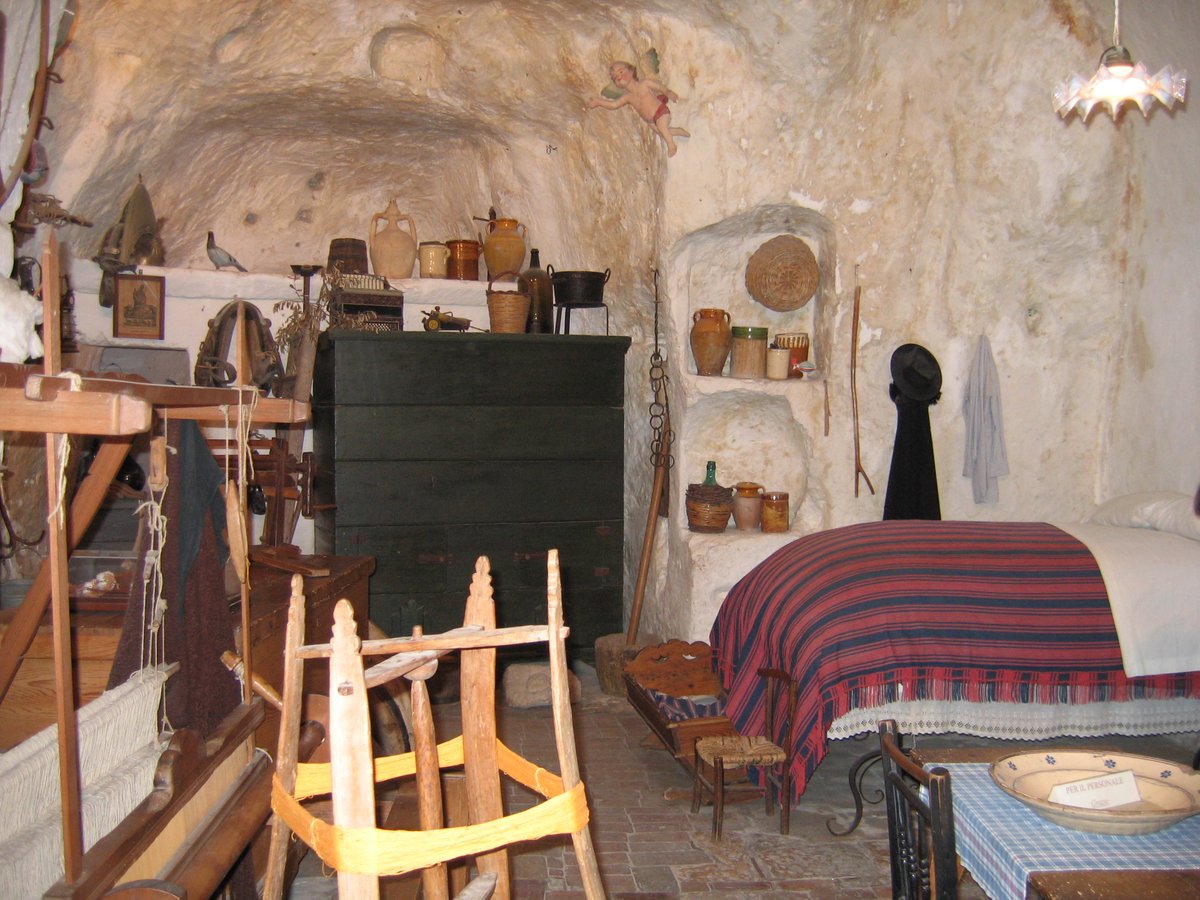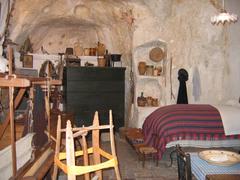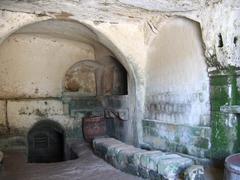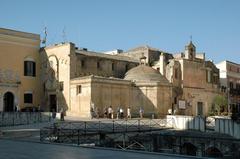
Casa Grotta Visiting Hours, Tickets, and Guide to Matera Historical Sites
Date: 14/06/2025
Introduction
Nestled within the ancient Sassi districts of Matera, Italy, Casa Grotta provides a captivating journey into one of the world’s oldest continuously inhabited urban settlements. These remarkable cave dwellings, carved into the limestone cliffs of the Gravina gorge, illustrate over 9,000 years of human ingenuity, adaptation, and resilience. Today, Casa Grotta stands as both a testament to Matera’s rich heritage and a symbol of its transformation from marginalized outpost to UNESCO World Heritage Site and 2019 European Capital of Culture. This guide presents detailed information on visiting hours, ticketing, accessibility, historical context, and nearby attractions to help you plan an enriching visit to Matera’s iconic cave homes (lionsinthepiazza.com; casagrottanarrante.com; My Adventures Across the World).
Table of Contents
- Introduction
- The Origins and Evolution of Casa Grotta
- Socioeconomic Transformation of Matera
- Daily Life and Architectural Features of Casa Grotta
- Practical Visitor Information
- Cultural and Symbolic Significance
- Preservation and Modern Use
- Casa Grotta as a Lens on Matera’s Identity
- Frequently Asked Questions (FAQ)
- Visuals and Media Suggestions
- Conclusion and Call to Action
The Origins and Evolution of Casa Grotta
The Sassi di Matera—comprising Sasso Caveoso and Sasso Barisano—are renowned for their labyrinthine network of cave dwellings, churches, and communal spaces. These were hewn directly from the soft tuff limestone, a process known as “negative architecture” (lionsinthepiazza.com). Initially, the caves offered rudimentary shelter, but over centuries, they evolved into complex homes featuring separate rooms, stables, cisterns, and storage areas. By the Middle Ages, the Sassi were densely populated, with families and livestock often sharing the same space (adventurebackpack.com).
Socioeconomic Transformation of Matera
By the mid-20th century, Matera’s cave districts were synonymous with poverty and poor living conditions, culminating in the city being labeled “the shame of Italy” (casagrottanarrante.com). The government evacuated thousands of residents, leaving the Sassi largely abandoned. Restoration efforts in the late 20th century culminated in the Sassi’s UNESCO World Heritage designation in 1993 and Matera’s recognition as European Capital of Culture in 2019 (lionsinthepiazza.com). Today, Casa Grotta exemplifies this journey from neglect to revival.
Daily Life and Architectural Features of Casa Grotta
A typical Casa Grotta, especially the renowned Casa Grotta di Vico Solitario, features a large chamber subdivided into living, sleeping, and storage areas. Furnishings include wooden beds, rustic kitchen implements, woven baskets, and simple tools (italyunseen.com). The cave’s natural insulation maintained a stable climate, but lack of ventilation led to dampness and health issues. Water was collected in cisterns, and food was stored in the cool recesses. Families often lived alongside animals, which contributed warmth but also presented challenges for hygiene (londoncitycalling.com).
Practical Visitor Information
Visiting Hours
- Casa Grotta di Vico Solitario: Open daily from 9:30 AM to 6:30 PM, including Sundays and holidays. Group visits outside these hours can be arranged by advance booking (materaonline.com).
- Most Casa Grotta sites in the Sassi districts are open from 9:00 AM until sunset.
Tickets
- Casa Grotta di Vico Solitario:
- Standard: €3.00
- Reduced (authorized guides, ages 11–18, F.A.I. members): €2.00
- School groups: €1.50/student
- Free: Children under 11, authorized guides
- Tickets grant access to Casa Grotta, Neviere (ancient snow storehouse), a natural cave, and the Rupestrian Church of San Pietro in Monterrone (casagrotta.it).
- Other Casa Grotta sites: €3–€5, with combined tickets and reductions available (My Adventures Across the World).
Accessibility
- The Sassi districts have uneven stone paths and stairs; accessibility is limited for visitors with mobility impairments (earthtrekkers.com).
- Some sites have made improvements; visitors with mobility needs should contact sites in advance.
Guided Tours and Events
- Guided tours are offered in multiple languages, highly recommended for historical insights (casagrotta.it; My Adventures Across the World).
- Special events and exhibitions are occasionally hosted, highlighting local crafts, music, and traditions (cultureactivities.com).
Nearby Attractions
- Church of San Pietro Caveoso and Laboratory Museum of Rural Life are steps away.
- Casa Noha: Multimedia history of Matera (alifeofy.com).
- Rock-hewn churches: Chiesa di Santa Lucia alle Malve, Chiesa di San Pietro Barisano (trip101.com).
- MUSMA: Museum of Contemporary Sculpture (alongdustyroads.com).
- Palombaro Lungo: Vast underground cistern, guided tours available.
- Parco della Murgia Materana: Hiking, panoramic views, ancient churches.
Travel Tips
- Wear sturdy, non-slip shoes for uneven terrain.
- Dress in layers; caves are cool even in summer.
- Carry water and cash for small purchases.
- Photography is permitted; respect restrictions where posted.
- Visit early or late in the day for fewer crowds and softer light.
Cultural and Symbolic Significance
Casa Grotta embodies Matera’s resilience and communal spirit. The Sassi’s interconnected homes—where one dwelling’s roof forms another’s garden—reflect a rare, organic urban layout rooted in cooperation and adaptation (lionsinthepiazza.com). Museums and restored cave homes now educate visitors about Matera’s history, from hardship and marginalization to cultural renaissance (londoncitycalling.com).
Preservation and Modern Use
Many Casa Grotta museums are managed by local families or cooperatives, offering personal stories that enrich the visitor experience (evendo.com). Some also house artisan shops, sustaining traditional crafts. Beyond museums, many cave dwellings have been adapted into boutique hotels, restaurants, and galleries, blending historic authenticity with modern comfort (italyunseen.com).
Casa Grotta as a Lens on Matera’s Identity
The story of Casa Grotta is the story of Matera itself—endurance, resourcefulness, and renewal. Exploring these spaces invites reflection on the human capacity to thrive in challenging conditions and on the ongoing dialogue between past and present (theurgetowander.com).
Frequently Asked Questions (FAQ)
Q: What are Casa Grotta di Vico Solitario’s visiting hours?
A: Open daily from 9:30 AM to 6:30 PM.
Q: How much do tickets cost?
A: Typically €3.00–€3.50 for adults, with reductions for children, students, and groups.
Q: Are guided tours available?
A: Yes, in multiple languages. Booking ahead is recommended for groups.
Q: Is Casa Grotta accessible for wheelchair users?
A: Accessibility is limited due to historic terrain. Contact sites in advance for assistance.
Q: Is photography allowed?
A: Yes, but flash and tripods may be restricted.
Q: What’s the best time to visit?
A: Spring and early autumn for mild weather and smaller crowds; early mornings or late afternoons are ideal.
Visuals and Media Suggestions
- Include high-resolution photos of Casa Grotta interiors, highlighting period furnishings and architectural details.
Alt text example: “Authentic interior of Casa Grotta cave dwelling in Matera with traditional furniture.” - Add a map of the Sassi showing Casa Grotta locations and major landmarks.
- Embed a virtual tour or video walkthrough for remote exploration.
Conclusion and Call to Action
A visit to Casa Grotta in Matera is more than a tour of ancient homes—it’s an immersive encounter with a resilient culture that has adapted and thrived through millennia. To make the most of your experience, check official visiting hours, secure your tickets in advance during peak seasons, and consider guided tours for deeper insights. Explore surrounding historical sites, enjoy local cuisine in cave restaurants, and, if possible, spend a night in a cave hotel for the full Matera experience.
For audio tours, practical tips, and up-to-date travel guidance, download the Audiala app. Follow us on social media for the latest on Matera and other Italian cultural gems. Embark on a journey that blends past and present in one of Italy’s most extraordinary cities.
Sources and Further Reading
- lionsinthepiazza.com
- casagrottanarrante.com
- My Adventures Across the World
- materaonline.com
- alifeofy.com
- Tourist Secrets
- A Passion and a Passport
- travellingking.com
- earthtrekkers.com
- italyunseen.com
- cultureactivities.com
- londoncitycalling.com
- evendo.com
- casagrotta.it
- trip101.com
- alongdustyroads.com
- theurgetowander.com



